Exposing the Myths and Realities of Good Cat Housing
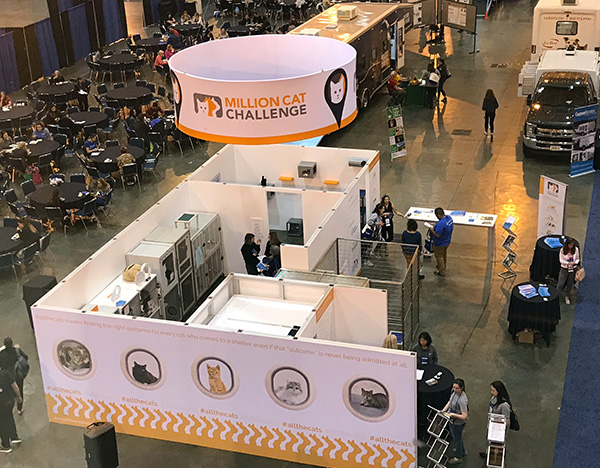 This year, we created a booth all about housing, because housing can mean the difference between life and death for a cat in a shelter. Bad housing creates stress, stress leads to URI, and URI can lead to unnecessary euthanasia.
This year, we created a booth all about housing, because housing can mean the difference between life and death for a cat in a shelter. Bad housing creates stress, stress leads to URI, and URI can lead to unnecessary euthanasia.
We'd like to say a big Million Cat thank you to Animal Arts Design, who designed and coordinated the booth project pro bono, and to our booth sponsors, Petco Foundation, Vetoquinol, and the Michigan Pet Fund Alliance. More than a thousand people visited the booth, and reviews ranged from "Amazing!" to "Pungent!" (the latter referring in particular to the Bad Cat Housing Challenge—see below).
Huge as it was, our booth wasn't big enough to hold all the information we wanted to share about keeping cats healthy and happy during their time in a shelter. Plus, we didn't expect visitors to spend the whole Expo there, and we know not everyone who wants to attend gets to go! Whether you were there and want more information, or you couldn't be there but want to see what you missed, we've got you covered here.
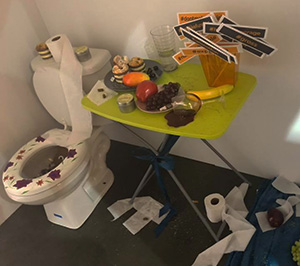
Before we get to best practices, here's a bit about the stinkiest part of our booth. In order to get to the good stuff, visitors to the exhibit had to take the Bad Cat Housing Challenge. We asked them to spend a minute in a cramped space with food next to a toilet, no natural light, the scent of urine and who-knows-what-else, and the sound of barking dogs (see photo at right, and be glad you can't smell it). It was our attempt to show what inadequate cage housing might feel like for a cat in a shelter.
Exiting on the other side of the Bad Cat Housing Challenge, visitors were treated to a display of portalized cages and other examples of better housing for shelters of all budgets, along with great examples of Do-It-Yourself bedding and other inexpensive housing enhancements you can provide for the cats in your care. It's all about reducing stress and disease, and increasing adoptability.
Read on to find information contained in or hinted at on the "good side" of the Million Cat Challenge Expo 2019 booth, and see what you want to try. Your cats will love you for it, and so will your staff, colleagues, volunteers, and adopters.
Single cat housing
In general, all individual cat shelter housing should:
- Be used such that during average intake times no more than 80% of housing be occupied. Open housing units are a must for shelters to function effectively day to day. Challengers know this principle as the key initiative Capacity for Care.
- Provide double compartments of adequate space for animal housed
- Provide a place for retreat within the housing unit
- Allow human/animal interaction to readily occur at the front of the housing unit
- Maximize the floor space by utilizing raised beds and elevated food/water dishes
- Provide fresh, clean food and water daily
- Provide choice for the animal within the housing unit (soft and hard surfaces, cool and warm surfaces, floor and elevated height spaces, hiding/retreat space, window viewing, etc.)
- Be located in a quiet environment
- Provide natural lighting
- Provide adequate ventilation
- Provide visual stimulation
- Have surfaces that are easy to clean and disinfect
For more details, and the science behind these recommendations, see Shelter housing for cats: Practical aspects of design and construction, and adaptation of existing accommodation published in the Journal of Feline Medicine and Surgery in July, 2018.
Flex Your Quads
For adoption housing these units can be set up to use top to bottom. Cats tend to stay in the upper unit to interact with adopters while the litter box stays out of the way in the lower compartment. These can be set up in the usual side to side fashion, if that better suits the cat or the units need to be put to use in other areas of the shelter.
When you don't have a lot of cats on the adoption floor, open all the portals so a single adult cat can have all the compartments - room to show off their stretching prowess in all its glory.
These units also adapt well to day-long adoption events when housing space is at a premium and the stay is very short (up to a few hours). Close those portals and move fast tracking kittens out to new homes in the blink of an eye.
Portalized quad cages: the flexibility is a boon both on the adoption floor and in the back.
Group cat housing
Individually-housed cats require a minimum of at least 8.5 square feet of clear floor space, so does that mean three cats housed together only need triple that amount? Turns out they actually need more. At least 18 square feet per cat, plus places to hide.
Group housing may be preferred for more difficult to rehome cats (provided they are able to socialize with others), especially where single-unit housing is unsuitable for a long stay. Stable groups and consistent husbandry have been shown to reduce stress in such environments. This may be facilitated by reducing group sizes, which might require thoughtfully subdividing larger open spaces.
For more details, and the science behind these recommendations, see Shelter housing for cats: Practical aspects of design and construction, and adaptation of existing accommodation published in the Journal of Feline Medicine and Surgery in July, 2018.
DIY Housing Accessories
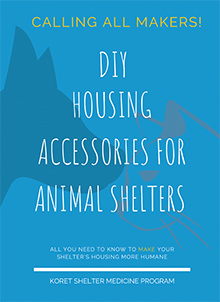 Ready to start a project? Click on the image to the right or visit the links below.
Ready to start a project? Click on the image to the right or visit the links below.
Dr. Denae Wagner of the UC Davis Koret Shelter Medicine Program is on a mission. OK, two missions. First, she wants every individually-housed cat in a shelter to have at least 8.5 square feet of floor space and a double-compartment cage with food and bedding on one side and litter on the other.
Most shelters can't afford to throw away their single-compartment cages and buy all new double-compartment cages, so Dr. Wagner led a team that created the Portal, a way to join two cramped single-compartment cages and turn them into a spiffy double-compartment cat condo. Originally, Dr. Wagner used PVC pipes and made the portals by hand. Eventually, she had them manufactured, and you can buy them from Shor-Line. If that's beyond your budget, you can still find a guide to make your own portals the way Dr. Wagner did at the beginning.
Dr. Wagner continues her tradition of hand-crafting shelter items cheaply using commonly-available materials. And her second mission is to show you how you can do it too, with the DIY Housing Accessories for Animal Shelters handbook. You can pick one up at the Million Cat Challenge Expo booth. Can't get one there? Don't worry, you can download the handbook below, or visit the DIY section of sheltermedicine.com.
Raised Bed
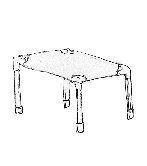 Even in a portalized cage, floor space is at a premium. Remember, individually housed cats need at least 8.5 square feet of floor space to stay healthy and relaxed. We want cats to have the maximum space to walk, stretch, and turn around. Elevated beds magically open up usable floor space... and they do so much more to enrich cages!
Even in a portalized cage, floor space is at a premium. Remember, individually housed cats need at least 8.5 square feet of floor space to stay healthy and relaxed. We want cats to have the maximum space to walk, stretch, and turn around. Elevated beds magically open up usable floor space... and they do so much more to enrich cages!
For example, you can drape a towel from the bed to give the cat a(nother) place to hide. Some cats prefer a little privacy while they dine. These cats would love to use the new hiding place to eat if their door-mounted dish is too scary.
Also, the bed provides a soft surface. One sign of good housing is that the cat has a variety of textures to choose from when they lie down.
And let’s face it, cats love to survey their inferiors from a royal perch!
Our friends at Kuranda make great elevated cat beds. If you or some of your volunteers are crafty types, you can build raised beds with a little PVC piping and a piece of vinyl-coated fabric. No sewing required! More ambitious folks might want to build the four-platform cat climbing tower. Get the instructions in the DIY Housing Accessories for Animal Shelters guide.
Toy Story #1,847,177
Pixar can’t keep up with our Challenger shelters, who have produced over 1.8M sequels to the first feline saved as part of the Challenge.
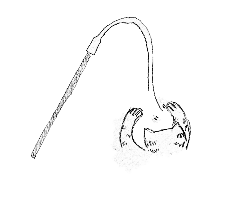 Each of those cats has a story. The cats who spent time on an adoption floor probably enjoyed grabbing at a noodle held aloft by a volunteer or knocking and chasing a ball around their cage quite a few times during their shelter stay. And they were so adorable batting around that stuffed mouse and that crumpled piece of paper with catnip hidden inside!
Each of those cats has a story. The cats who spent time on an adoption floor probably enjoyed grabbing at a noodle held aloft by a volunteer or knocking and chasing a ball around their cage quite a few times during their shelter stay. And they were so adorable batting around that stuffed mouse and that crumpled piece of paper with catnip hidden inside!
Cats also enjoy their rest, of course, and the chance to rub up against a potential adopter. But please be sure to leave those toys in the cage, because here’s a surprising plot twist: cats are more likely to be adopted when they have toys in their cages... even if their adopter never sees the cat playing with them.
Want to read the study? Here's the citation:
Fantuzzi, J. M., et al. (2010). "Factors relevant to adoption of cats in an animal shelter." J Appl Anim Welf Sci 13(2): 174-179.
This study performed a multifactor analysis of the effects of the provision of toys, cage location, and cat characteristics (activity level, age, sex, and coat color) on 111 cats available for adoption in a nonhuman animal shelter. The analysis revealed a greater adopter viewing of cats housed at eye level and of those with toys-even though the toys did not affect the cats' behavior.
Note: Not all toys should be left with unsupervised cats, of course, so make sure you only leave toys the cat can chew on safely. The DIY guide includes three toy projects. Make your own noodles, paper treat balls, and pipe cleaner toys.
DIY by KSMP
Sanitation station
Looking for general information about how to provide sanitation in animal shelters? This guide from sheltermedicine.com is a great place to start.
 On the Other Hand
On the Other Hand
It had been widely believed that hand washing was the next best choice when gloves are impractical. However, current research suggests that hand sanitizers are just as good as or even better than hand washing in some circumstances - and a lot easier to use.
It is true that proper hand washing has the significant advantage of removing even the most resistant pathogens, and is therefore required under certain circumstances (e.g. when hands are contaminated with feces, blood or bodily fluids, are visibly soiled, or after suspected exposure to a durable pathogen such as parvovirus or ringworm). But it is surprisingly hard to wash hands correctly, and compliance may not be all one could wish for.
Even though the spectrum of effect may be limited, a slightly less effective method, used consistently and correctly, will provide better results than the theoretically-ideal choice. In one study that compared the bacterial levels on vet students’ hands after performing an exam on a horse, bacterial counts were actually lower on the hands of those who used a hand sanitizer compared to those who washed and dried (Traub-Dargatz JL, JL, Weese JS, Rousseau JD, et al. Pilot study to evaluate 3 hygiene protocols on the reduction of bacterial load on the hands of veterinary staff performing routine equine physical examinations. Can Vet J 2006;47:671-676.).
Read more about proper hand-washing technique.

That's the Spot
Spot cleaning done right is healthier for cats and more efficient for shelter staff than daily full cleaning and disinfection.
Spot cleaning is accomplished with the cat remaining in one side of a double-compartment housing unit while the other is tidied, beds made, litter box maintained and any remaining food and water removed and a fresh supply provided. Actual cleaning (soap and water or disinfectant cleaner) only occurs as needed to remove organic material from the surface areas - for many housing units this is not needed on a daily basis.
Spot cleaning reduces cat stress (a leading cause of URI) by minimizing handling and disruption during the most stressful time of day: cleaning time. Spot cleaning also helps reduce risk of disease transmission because cats are minimally handled during cleaning thus the movement of germs from one cat to another is greatly reduced. And of course time not spent deep cleaning can be better spent elsewhere by staff.
Can you spot clean group cat housing and single-compartment individual cat housing too? Yes.
Read more and download instructions for spot cleaning a cat cage.

Room to Breathe
Fast track cats require an absolute minimum of 8 square feet of floor space and separation between their food and kitty litter. Of course, they'd love more! They have stretching, pouncing, lording and wooing to do, as you know. Cats staying more than two weeks need more room to stay healthy and ready for adoption.
A stressed cat is more likely to stay longer and get sick, and less likely to present her best self to potential adopters. Adequately-sized housing minimizes stress by allowing cats to stretch, hide, and enjoy food away from the litterbox; additionally, it allows staff to clean with minimal handling/disruption of the cat's surroundings (see That's the Spot directly above).
In order to allow cats to assume most normal postures, housing needs to provide at least 28” by 30” of clear floor space (e.g. excluding space occupied by bed, food and water dishes and litter boxes). In order to accommodate a carrier or hiding box, this generally means a width of > 3 feet for a main compartment.
The height should be high enough to allow the cat to stand on their hind legs and fully extend their front legs without touching the roof of the enclosure, at least 30” with a shelf or other elevated perching space.
For more details, and the science behind these recommendations, see Shelter housing for cats: Practical aspects of design and construction, and adaptation of existing accommodation published in the Journal of Feline Medicine and Surgery in July, 2018.
The Agony of Da Feet
 Foot baths may not be the best tool to prevent disease spread. Why? Because they can be a headache to use and maintain correctly, and an incorrectly used footbath may actually spread disease.
Foot baths may not be the best tool to prevent disease spread. Why? Because they can be a headache to use and maintain correctly, and an incorrectly used footbath may actually spread disease.
If most foot baths currently in use are not likely effective and may create needless risk, there is little justification to use them in general shelter animal housing areas.
When serious disease is suspected, use dedicated shoes or shoe/boot covers. Rubber over-soles are fairly easy to step in and out of and can be kept in a variety of sizes directly outside of areas housing ill or quarantined animals.
If you're going to use foot baths, here are some ways to maximize their efficacy